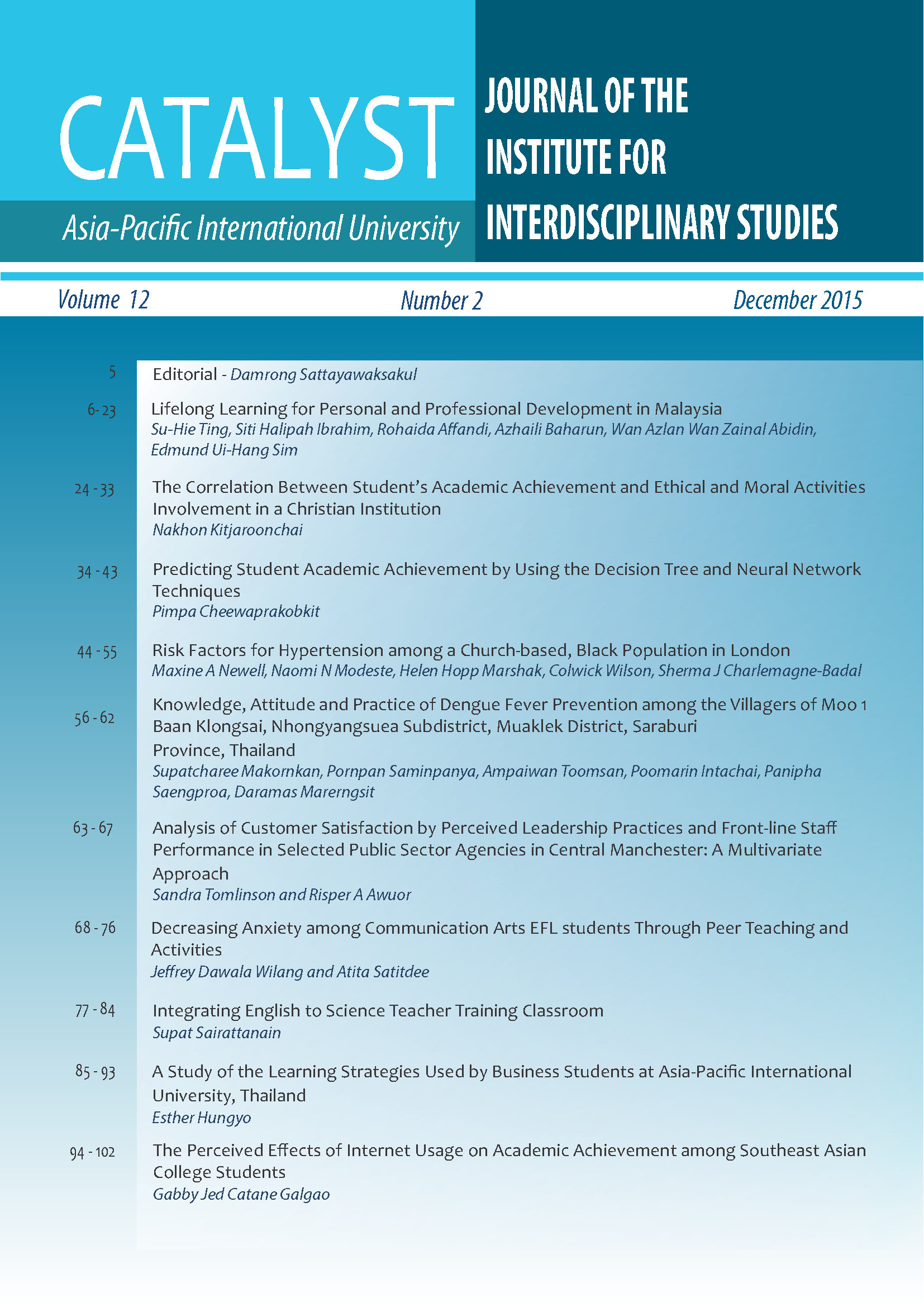The Relationship of Social Integration and Personal Development among University Students in Thailand
Main Article Content
Abstract
Social integration is a key component of the goals of higher education. Personal growth is often a result of pursuing higher education. The purpose of this study was to investigate the students' perceptions of social integration and personal growth. A cross-sectional survey design using a sample of 129 students revealed that the students have a low perception of their social integration while having a moderately high perception of their personal growth. There was no difference in perception of the variables of this study when comparisons were made by class level, gender, or major. A weak correlation was found between social integration and personal growth (n = 124, r = .20, p < 0.05).
Article Details

This work is licensed under a Creative Commons Attribution-NonCommercial-NoDerivatives 4.0 International License.
Copyright: Asia-Pacific International University reserve exclusive rights to publish, reproduce and distribute the manuscript and all contents therein.
References
Awang, M. M. (2012). An Exploration of Strategies Used by Malaysian Secondary Teachers for Promoting Positive Behaviour: Professionals and Pupils’ Perspectives (Unpublished PhD. thesis). United Kingdom: University of Dundee.
Bean, J. P. (2005). Nine themes of college student retention. In A. Seidman (Ed.), College student retention. Westport: Praeger Publishers. 215-243.
Braskamp, L. A. (2007). Fostering Religious and Spiritual Development of Students during College. Ankor Publishing.
Calvete, H. & Connor-Smith, J.K. (2006). Perceived social support, coping, and symptoms of distress in American and Spanish students. Anxiety, Stress, and Coping, 19(1), 47 – 65.
Chang, M. J., Astin, A.W., & Kim, D. (2004). Cross-racial interaction among undergraduates: Some consequences, causes, and patterns. Research in Higher Education, 45(5), 529-553.
Chaney, C. (2008). The benefits of church involvement for African Americans. Journal of Religion and Society, 10.
Chickering, A.W., &Reisser, L. (1993). Education and identity (2nd ed.). San Francisco: Jossey-Bass
Demaray, M. K., Malecki, C. K., Davidson, L. M., Hodgson, K. K., & Rebus, P. J. (2005). The Relationship Between Social Support And Student Adjustment: A Longitudinal Analysis. Psychology in the Schools, 42(7), 691-706.
Denson, N. & Zhang, S. (2010). The impact of student experiences with diversity on developing graduate attributes. Studies in Higher Education, 35(5), 529–543.
Elliott, M., & Hayward, R. D. (2007). Religion and the search for meaning in life. Journal of Counselling Psychology, 53, 80–93.
Ellison, C. G., & Levin, J. S. (1998). The religion–health connection: Evidence, theory, and future directions. Health Education & Behavior, 25, 700–720.
Fraenkel, J., Wallen, N., & Hyun, H. (2012). How to design and evaluate research in education (8th ed.). New York, NY: Mc-Graw-Hill.
Hartup, W.W., & Stevens, N. (1999). Friendships and adaptation across the life span.Current Direction in Psychological Science. 8, 76–79.
Hixenbaugh, P., Dewart, H. &Towell, T. (2013). What enables students to succeed? An investigation of socio-demographic, health and student experience variables. Psychodynamic Practice. 18(3), 285–301.
Idler, E. (2008). The psychological and physical benefits of spiritual/religious practices. Spirituality in Higher Education Newsletter, 4. 1.
Lin Y. N (2010). Taiwanese university students' perception of university life.Counseling Psychology Quarterly, 23(2), 189-202.
MacDonald, G., & Leary, M. R. (2005). Why does social exclusion hurt? The relationship between social and physical pain. Psychological Bulletin, 131, 202–223
Martikainen, L. (2009). Life satisfaction of university-educated young adults. Psychology of Happiness. Ova Science Publishers, Inc.
Martin, A. J., Mansour, M., Anderson, M., Gibson, R., Liem, G. A. D. &Sudmalis, D. (2013). The role of arts participation in students’ academic and nonacademic outcomes: A longitudinal study of school, home, and community factors. Journal of Educational Psychology,105(3), 709-727.
Oswald, H. &Suss, K.U. (1994). The influence of parents and peers on misconduct at school: simultaneous and synergistic effects. In Silbereisen, R.K. &Todt, E. (Eds.), Adolescence in Context: The Interplay of Family, School, Peers, and Work in Adjustment. New York: Springer-Verlag Inc.
Ozben, S. (2013) Social skills, life satisfaction, and loneliness: What enables students to succeed? An investigation of socio-demographic, health and student experience variables in Turkish university students. Social Behavior and Personality, 41(2), 203-214.
Peters, S. (2010). Shifting to the lense: Re-Framing the View of Learners during the Transition from Early Childhood. In D. Jindal-Snape (Ed.), New York: Routledge. Educational Transition, 6884.
Phillips, D. L. (1967). Social participation and happiness. American Journal of Sociology, 72(5), 479– 488.
Piaget, J. (1975). The equilibrium of cognitive structures: The central problem of intellectual development. Chicago: University of Chicago Press.
Riggio, R.E. (2003). Introduction to Industrial/Organizational Psychology, 4th Edition, Upper Saddle, N.J.: Prentice Hall.
Robitschek C, Ashton MW, Spering CC, Geiger N, Byers D, Schotts GC, Thoen MA. (2012). Development and psychometric evaluation of the Personal Growth Initiative Scale-II. J Counseling and Psychology, 59(2), 274-87.
Ross, S., & Straus, M. (1997). The social integration scale. Annual Meeting of the American Educational Research Association. Chicago.
Silbereisen, R.K. & Todt, E. (1994). The broader context of social influence in adolescence. In Silbereisen, R.K. & Todt, E. (Eds.), Adolescence in Context: The Interplay of Family, School, Peers, and Work in Adjustment. New York: Springer-Verlag Inc.
Topping, K. J., & Foggie, J. (2010). Interactive Behaviors for Building Independence in Exceptional Youth. In D. Jindal-Snape (Ed.), New York: Routledge. Educational Transition. 161-165.
Yaeda, J. (2010). Transition from Secondary School to Employment in Japan for Students with Disabilities. In D. Jindal-Snape (Ed.), New York: Routledge. Educational Transition, 205-222.
Yonker, J. E., Schnabelrauch, C. A, & DeHaan L. G. (2012). The relationship between spirituality and religiosity on psychological outcomes in adolescents and emerging adults: A meta-analytic review. Journal of Adolescence. 35(2):299–314.


